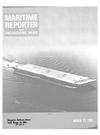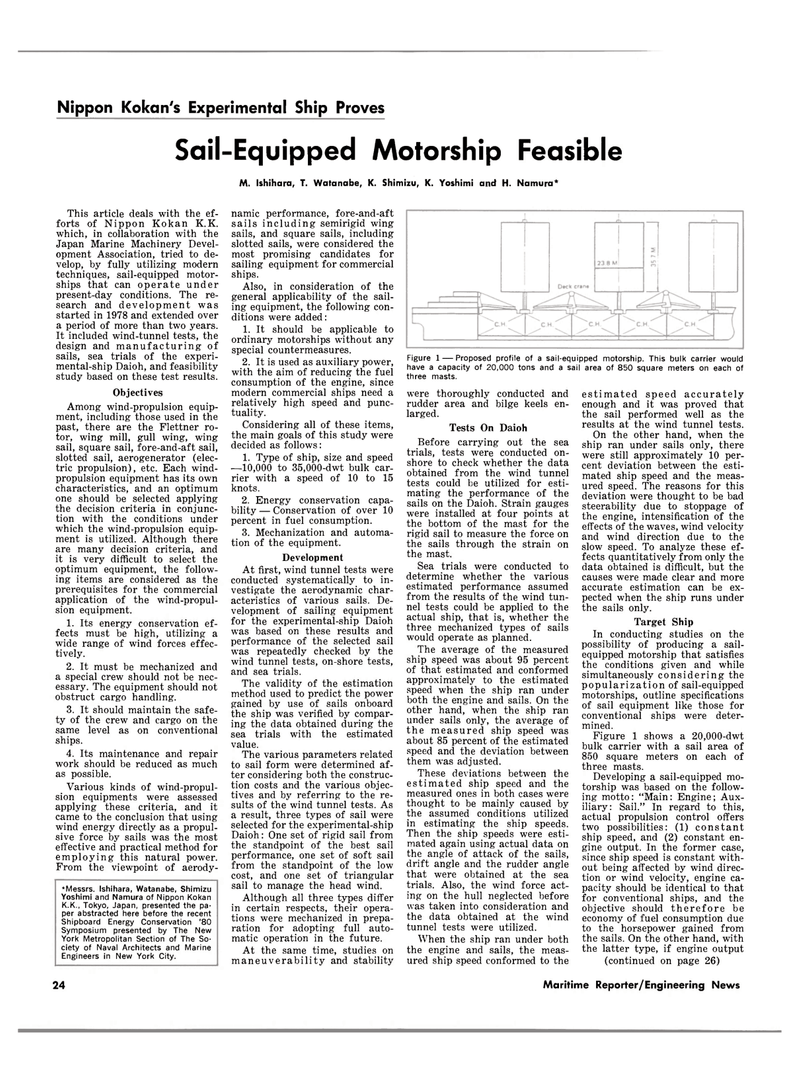
Page 22: of Maritime Reporter Magazine (March 15, 1981)
Read this page in Pdf, Flash or Html5 edition of March 15, 1981 Maritime Reporter Magazine
Nippon Kokan's Experimental Ship Proves
Sail-Equipped Motorship Feasible
M. Ishihara, T. Watanabe, K. Shimizu, K. Yoshimi and H. Namura*
Figure 1 — Proposed profile of a sail-equipped motorship. This bulk carrier would have a capacity of 20,000 tons and a sail area of 850 square meters on each of three masts.
This article deals with the ef- forts of Nippon Kokan K.K. which, in collaboration with the
Japan Marine Machinery Devel- opment Association, tried to de- velop, by fully utilizing modern techniques, sail-equipped motor- ships that can operate under present-day conditions. The re- search and development was started in 1978 and extended over a period of more than two years.
It included wind-tunnel tests, the design and manufacturing of sails, sea trials of the experi- mental-ship Daioh, and feasibility study based on these test results.
Objectives
Among wind-propulsion equip- ment, including those used in the past, there are the Flettner ro- tor, wing mill, gull wing, wing sail, square sail, fore-and-aft sail, slotted sail, aerogenerator (elec- tric propulsion), etc. Each wind- propulsion equipment has its own characteristics, and an optimum one should be selected applying the decision criteria in conjunc- tion with the conditions under which the wind-propulsion equip- ment is utilized. Although there are many decision criteria, and it is very difficult to select the optimum equipment, the follow- ing items are considered as the prerequisites for the commercial application of the wind-propul- sion equipment. 1. Its energy conservation ef- fects must be high, utilizing a wide range of wind forces effec- tively. 2. It must be mechanized and a special crew should not be nec- essary. The equipment should not obstruct cargo handling. 3. It should maintain the safe- ty of the crew and cargo on the same level as on conventional ships. 4. Its maintenance and repair work should be reduced as much as possible.
Various kinds of wind-propul- sion equipments were assessed applying these criteria, and it came to the conclusion that using wind energy directly as a propul- sive force by sails was the most effective and practical method for employing this natural power.
From the viewpoint of aerody- namic performance, fore-and-aft sails including semirigid wing sails, and square sails, including slotted sails, were considered the most promising candidates for sailing equipment for commercial ships.
Also, in consideration of the general applicability of the sail- ing equipment, the following con- ditions were added: 1. It should be applicable to ordinary motorships without any special countermeasures. 2. It is used as auxiliary power, with the aim of reducing the fuel consumption of the engine, since modern commercial ships need a relatively high speed and punc- tuality.
Considering all of these items, the main goals of this study were decided as follows: 1. Type of ship, size and speed —10,000 to 35,000-dwt bulk car- rier with a speed of 10 to 15 knots. 2. Energy conservation capa- bility — Conservation of over 10 percent in fuel consumption. 3. Mechanization and automa- tion of the equipment.
Development
At first, wind tunnel tests were conducted systematically to in- vestigate the aerodynamic char- acteristics of various sails. De- velopment of sailing equipment for the experimental-ship Daioh was based on these results and performance of the selected sail was repeatedly checked by the wind tunnel tests, on-shore tests, and sea trials.
The validity of the estimation method used to predict the power gained by use of sails onboard the ship was verified by compar- ing the data obtained during the sea trials with the estimated value.
The various parameters related to sail form were determined af- ter considering both the construc- tion costs and the various objec- tives and by referring to the re- sults of the wind tunnel tests. As a result, three types of sail were selected for the experimental-ship
Daioh: One set of rigid sail from the standpoint of the best sail performance, one set of soft sail from the standpoint of the low cost, and one set of triangular sail to manage the head wind.
Although all three types differ in certain respects, their opera- tions were mechanized in prepa- ration for adopting full auto- matic operation in the future.
At the same time, studies on maneuverability and stability were thoroughly conducted and rudder area and bilge keels en- larged.
Tests On Daioh
Before carrying out the sea trials, tests were conducted on- shore to check whether the data obtained from the wind tunnel tests could be utilized for esti- mating the performance of the sails on the Daioh. Strain gauges were installed at four points at the bottom of the mast for the rigid sail to measure the force on the sails through the strain on the mast.
Sea trials were conducted to determine whether the various estimated performance assumed from the results of the wind tun- nel tests could be applied to the actual ship, that is, whether the three mechanized types of sails would operate as planned.
The average of the measured ship speed was about 95 percent of that estimated and conformed approximately to the estimated speed when the ship ran under both the engine and sails. On the other hand, when the ship ran under sails only, the average of the measured ship speed was about 85 percent of the estimated speed and the deviation between them was adjusted.
These deviations between the estimated ship speed and the measured ones in both cases were thought to be mainly caused by the assumed conditions utilized in estimating the ship speeds.
Then the ship speeds were esti- mated again using actual data on the angle of attack of the sails, drift angle and the rudder angle that were obtained at the sea trials. Also, the wind force act- ing on the hull neglected before was taken into consideration and the data obtained at the wind tunnel tests were utilized.
When the ship ran under both the engine and sails, the meas- ured ship speed conformed to the estimated speed accurately enough and it was proved that the sail performed well as the results at the wind tunnel tests.
On the other hand, when the ship ran under sails only, there were still approximately 10 per- cent deviation between the esti- mated ship speed and the meas- ured speed. The reasons for this deviation were thought to be bad steerability due to stoppage of the engine, intensification of the effects of the waves, wind velocity and wind direction due to the slow speed. To analyze these ef- fects quantitatively from only the data obtained is difficult, but the causes were made clear and more accurate estimation can be ex- pected when the ship runs under the sails only.
Target Ship
In conducting studies on the possibility of producing a sail- equipped motorship that satisfies the conditions given and while simultaneously considering the popularization of sail-equipped motorships, outline specifications of sail equipment like those for conventional ships were deter- mined.
Figure 1 shows a 20,000-dwt bulk carrier with a sail area of 850 square meters on each of three masts.
Developing a sail-equipped mo- torship was based on the follow- ing motto: "Main: Engine; Aux- iliary: Sail." In regard to this, actual propulsion control offers two possibilities: (1) constant ship speed, and (2) constant en- gine output. In the former case, since ship speed is constant with- out being affected by wind direc- tion or wind velocity, engine ca- pacity should be identical to that for conventional ships, and the objective should therefore be economy of fuel consumption due to the horsepower gained from the sails. On the other hand, with the latter type, if engine output (continued on page 26) •Messrs. Ishihara, Watanabe, Shimizu
Yoshimi and Namura of Nippon Kokan
K.K., Tokyo, Japan, presented the pa- per abstracted here before the recent
Shipboard Energy Conservation '80
Symposium presented by The New
York Metropolitan Section of The So- ciety of Naval Architects and Marine
Engineers in New York City. 24 Maritime Reporter/Engineering News

 21
21

 23
23
